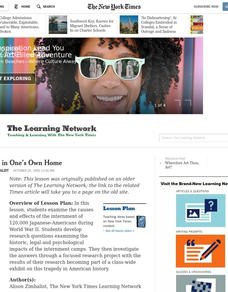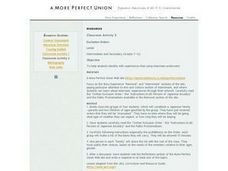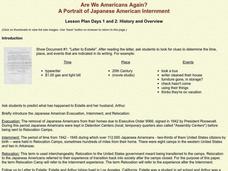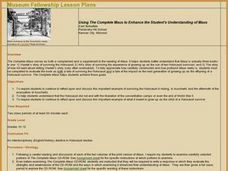Smithsonian Institution
The Soldier’s Experience—Vietnam versus World War I
The Vietnam War and World War I were two very important—and different—wars. To understand the differences, and similarities, class members watch videos, examine primary source documents, and then create a newscast that examines the...
US National Archives
The Home Front: How Did People Prepare for the War at Home?
Wars have a profound effect not only on a country's soldiers, but also on the everyday lives of its citizens. Invite young historians to discover how Britain prepared for the second World War by analyzing a series of government posters...
Curated OER
The People of World War Two
Students explore how those children returning felt isolated and how shocked they were by the changes in Britain. They explain the impact that World War Two had upon the generation born during the war. Students explore how people felt...
Curated OER
Italian Enemy Aliens During World War II: Evacuation from Prohibited Zones
Students read and discuss the Enemy Alien Evacuation Order. They perform research by reading newspaper articles from February 1942 as well as investigating available information on the Internet. Students work in groups to create a...
Curated OER
Prisoner in One's Own Home
Examine the internment of Japanese-Americans during World War II. After reading an article from the New York Times and exploring the author's word choice, young readers find the central idea in the text and work on researching...
Curated OER
Evacuation: The Japanese Americans in World War II
Students examine Japanese internment camps of World War II. In this World War II lesson, students use primary and secondary sources to research the evacuation process and life within the internment camps. Students discuss the racial bias...
Curated OER
Journey to Topaz, a Literature Based Approach
Students view a video clip of the experiences of Japanese-Americans during World War II. They read parts of a book in which a child tells her story about living in the internment camps. They participate in a simulation activity as well.
Curated OER
Nothing to Fear but Fear Itself
Students investigate the years during World War II in which Japanese Americans living on the West Coast were held in internment camps.
Curated OER
Letters from the Japanese American Internment
Students explore the concept of Japanese internment. In this Japanese internment lesson, students examine primary sources that enable them to discover what internment camp life was like and its implications, Students write their own...
Curated OER
Exclusion Orders
Students work in groups that represent a Japanese family who have received orders that they will be evacuated. Students read the "Civilian Exclusion order." They have 15 minutes to decide what they will carry. Choices must be justified...
Curated OER
The Aleut Evacuation: An Overlooked Injustice
Students read and complete activities about the Aleut tribe and Russian impact on the people. In this Aleut and Russian history instructional activity, students read a passage about the history between the Russians and the Aleut tribe....
Curated OER
Defining Moments From the Past: Japanese American Internment
Students conduct a mock Congressional Hearing to decide whether or not Japanese Americans who were sent to internment camps during World War II should be provided financial restitution. They research and create a time line of events...
Scholastic
Dear Miss Breed
This compelling plan based on the letters in the book Dear Miss Breed engages readers in learning what it was like for Japanese Americans following the attacks at Pearl Harbor. After reading the letters, young scholars will...
Curated OER
American Justice on Trial
Young scholars role play a trial in which they consider if the United States government violated the rights of Japanese Americans after Pearl Harbor.
Curated OER
Are We Americans Again? A Portrait of Japanese American Internment
Young scholars study letters and images of the Japanese American Interment during World War II. They discuss the issues presented.
Curated OER
Do Suspected Enemies Have Rights?
Students investigate the history of Japanese immigration. They complete an online Webquest, explore various websites, answer discussion questions, and locate and read newspaper articles about enemy compatants.
Curated OER
Africa Colors a Destiny
Learners discover the peace corps and the culture of Chad. For this cultural awareness lesson, students watch a slide show and examine various primary sources from peace corps volunteers in Africa. This lesson includes web-links,...
Curated OER
Night: Annotated Bibliography
This annotated bibliography and list of websites are valuable resources for any study of the Holocaust and/or of Elie Wiesel's Night.
Curated OER
Using The Complete Maus to Enhance the Student's Understanding of Maus
Students read The Complete Maus to explore how Maus is actually three books in one. In groups, they evaluate the book as a tale of surviving the Holocaust and a tale of impacting future generations. They examine the conditions at...
Curated OER
Flawed Democracies, Human Rights
Students create drawing that tell a story about a young girl's life in an internment camp. In this internment camp lesson plan, students hear stories and analyze photographs of internment camps and then create their own drawings.



















